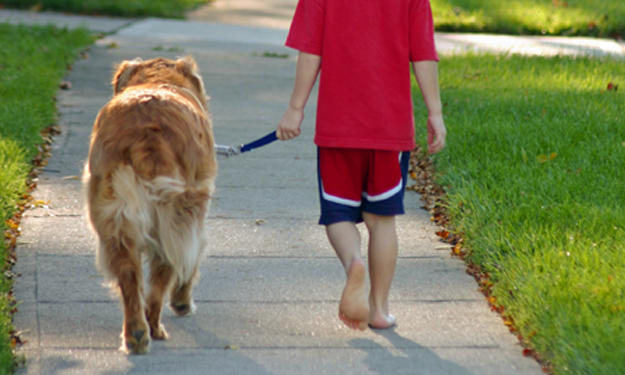How to Protect Your Dog’s Paws in the Summer heat

We have all been hearing about the dangers of leaving our pets in hot cars during the heat of the summer, but there are other summer-time concerns of equal importance that don’t get the attention they deserve. Consider the idiom “hot enough to fry an egg on the sidewalk”, now let’s think about how that must feel on our pets’ feet.
Given the right circumstances, asphalt can be 40 to 60 degrees hotter than the air temperature. This means temperatures that can exceed 140 degrees! We all know to wear shoes or sandals so that our feet don’t get burned. Dogs obviously have much tougher feet, but even their thicker pads can be injured by really hot surfaces. Sidewalks, asphalt, wood, metal, sand and car or truck beds and surfaces can get very hot during the summer months. These materials absorb heat from the sun and retain that heat for hours, even after the sun has gone down.
Signs & Symptoms
As a basic ‘rule of paw,’ if the pavement feels too hot for your bare foot, it is too hot for your pet.
Milder burns can be hard to spot, especially if a dog’s pads are black. If you have been outdoors for an extended period of time with your pet, and they are either limping or constantly licking their paw(s), it’s likely they have burned their pads. If you see any of the following signs in your dog, see your veterinarian right away:
- limping
- refusing to walk
- red or pink color change in the paw pads
- licking or chewing at the feet
- missing pieces of the pads or blisters
You should be especially vigilant after a dog has been swimming. Water softens the pads of a dog’s feet, making it more likely that hot surfaces like boat docks and pavement will cause them to burn.
Foot pads can also be more prone to developing abrasive injuries during the summer months; this includes blistered foot pads resulting from activities where the dog is skidding or sliding on the pavement, running, playing fetch, and chasing kids or other dogs. With puppies, it is very important to gradually introduce outdoor activities in the summer weather; their pads will toughen over time.
Tips to Protect Your Pet’s Paws
- Check the pavement for heat before taking your dog on a walk. Place your hand or a bare foot on the surface for 10 seconds. If it is too hot for you to keep your hand or foot on it, then it is too hot for your pet. Stay off the sidewalk, or go for a walk later in the day.
- Stay on grassy, soft surfaces, and try to walk in the shade when possible.
- Avoid the hottest parts of the day – walk early in the morning or late in the evening after the pavement has cooled down.
- Invest in a pair of booties to help keep the heat from burning your dog’s paws.
Treatment
If you notice a problem with your dog’s pads while out in the summer weather, flush the affected areas with cool water, or if available, apply a cool compress. Carry or walk your dog to a grassy, shaded area to prevent further burns. Another tip is to lay down a wet towel for your dog to stand on when grassy areas are not available.
Bandaging paws yourself is generally not recommended. If not done correctly, bandages can be placed too tight, damaging the foot and leg. Some dogs will tolerate a sock to keep the area clean, but caution is advised for dogs with a history of chewing and ingesting socks.
Ideally, your veterinarian should examine your dog for signs of deeper burns, blisters, and the possibility of infection as soon as possible. Your vet will determine if antibiotics or pain medication is needed.
Hopefully, these tips will help to prevent injury to your furry friend’s pads, and you will have a fun summer together!
Written by Dr. Sheila Bennett